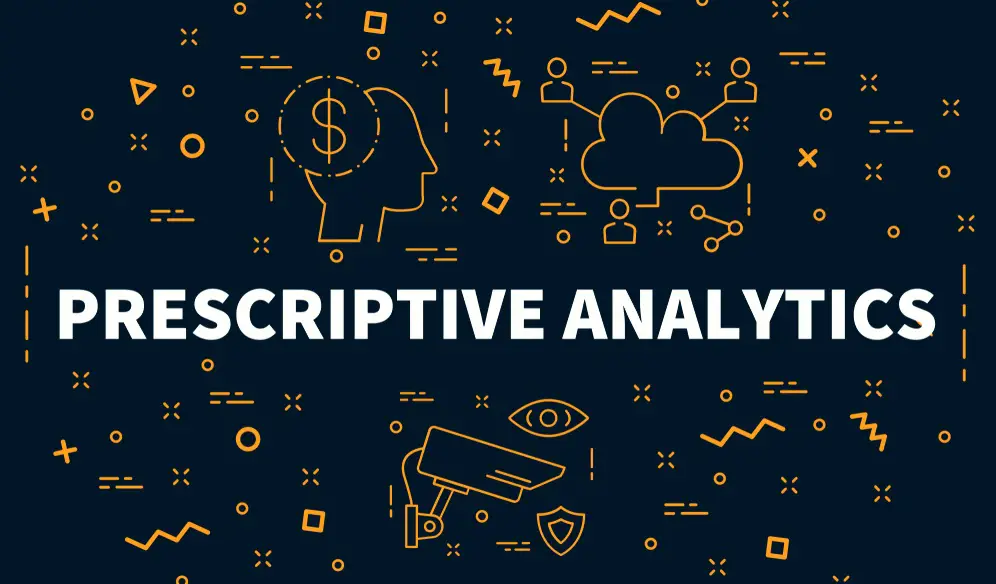Prescriptive analytics is the final phase of data analysis that incorporates predictive analytics and descriptive analytics. It is a highly valued process in business due to the fact that it helps companies strategize better and have higher degrees of success.
Table of Contents
- The Definition of Prescriptive Analytics
- The Benefits of Prescriptive Analytics
- Examples of Prescriptive Analytics
- Conclusion
The Definition of Prescriptive Analytics
Unlike the three other branches of analytics that precede it, prescriptive analytics does not just answer questions by providing information but also recommends appropriate courses of action.
It essentially tells you what your strategy should be, based on the data provided. It uses a variety of techniques such as machine learning, neural networks, artificial intelligence, heuristics, graph analysis, etc.
Prescriptive analytics combines the data-monitoring of descriptive analytics with the forecasting capabilities of predictive analytics to create actionable plans that a business can then implement into its decision-making.
It guides businesses to better manage fluctuations in the market and form approaches that will provide them with better results. It acts as a solution that promises safer results from a company’s pre-planned efforts.
Of course, companies can benefit even more from prescriptive analytics if they have the right tools. Having a good data infrastructure can maximize the efficiency of a prescriptive analytics tool by better utilizing its findings.
Companies can find even more success by fully taking advantage of the data and having processes that are made to work in tandem with the results of prescriptive analytics and technology.
The Benefits of Prescriptive Analytics
The benefits of how prescriptive analytics work are many and can be generated in many different ways.
Prescriptive analytics can help maximize profit in companies through different automations once implemented within a company’s decision-making process. For example, a company can use prescriptive analytics to study the market and predict its shifts.
It can then plan in advance or use technology to navigate these changes automatically. This would allow the company to automatically change its prices when needed and either minimize costs or increase profits.
This is especially helpful since, in real-time, these fluctuations happen so quickly that many businesses cannot keep up with them. Therefore, there is not enough time to take advantage of presented opportunities or deal with issues unless companies are already prepared to do so in advance or have a system in place that can automatically make adjustments as needed.
Prescriptive analytics also has some time-saving benefits. Because strategizing is so important in business, many companies spend a lot of time and resources on formulating the best strategic plans that will help them improve their operations and increase profit.
However, prescriptive analytics can help businesses make strategies faster and achieve more secure results.
No matter how much time a business spends designing the perfect solutions for their operations, these strategies never truly guarantee results.
In contrast, prescriptive analytics promises more accurate possible outcomes specifically because it is based on actual data. Therefore, companies can spend less time strategizing and more time dealing with their day-to-day tasks, improving operational efficiency.
Another great benefit of prescriptive analytics is that it does not require human involvement as much. When certain automations are in place, the need for human work is minimized. This is especially helpful because it reduces the chance of human error but also human bias.
Therefore, removing the possibility of human error will guarantee more accurate results. Moreover, with the need for employee involvement at a minimum, prescriptive analytics also reduces labor costs.
Examples of Prescriptive Analytics

There are a lot of examples of how prescriptive analytics can improve operations in many different fields.
In healthcare, prescriptive analytics can helps clinicians foresee the progression of a patient’s condition and already have treatment plan options in place, taking into consideration any possible developments in a patient’s health. This can significantly improve the level of quality of patient care.
More importantly, it can help save lives. In pharmaceuticals and generally in research, prescriptive analytics can be used to improve testing procedures.
For example, a prescriptive model can help in the selection and patient cohorts for clinical trials. Therefore, the process of these clinical trials can be accelerated, reducing costs and expediting the development of the drugs and the usually long approval process.
In marketing, experts can have a better understanding of their targeted audiences and can form more efficient marketing campaigns specifically tailored to them by relying on the results provided by prescriptive analytics. Therefore, marketing experts can spend less time developing their strategies but have tremendous success in their campaigns.
Moreover, a prescriptive analysis can improve customer satisfaction by suggesting approaches that will most likely entice the customers, as it would be based on their specific preferences, indicated by their past interactions with the companies.
Financial services can also benefit from a prescriptive analysis to better predict payment behavior and make a better decision on what needs to be done.
For example, many banks offer estimations of expected future charges to customers and make suggestions on financial issues through online banking. They also use this branch of business analytics to understand clients’ payment behavior.
Often, some of this information can also be provided to customers to better understand and manage the development of their credit score, as well as better account for possible payment delays.
In the field of insurance, prescriptive analytics are used in risk assessment models to determine the eligibility of clients and the pricing.
Conclusion
Prescriptive analytics applications are perhaps the most valuable branches of data analytics, as this analytical approach combines some of the other branches to produce accurate results and efficient strategies.
While the other branches offer information, a prescriptive model offers detailed courses of actionable insight for businesses to make informed decisions specifically based on big data generated from the companies themselves.
Therefore, since the data is specific to the company, the recommended strategies promise a higher level of success and, consequently, higher profit.



